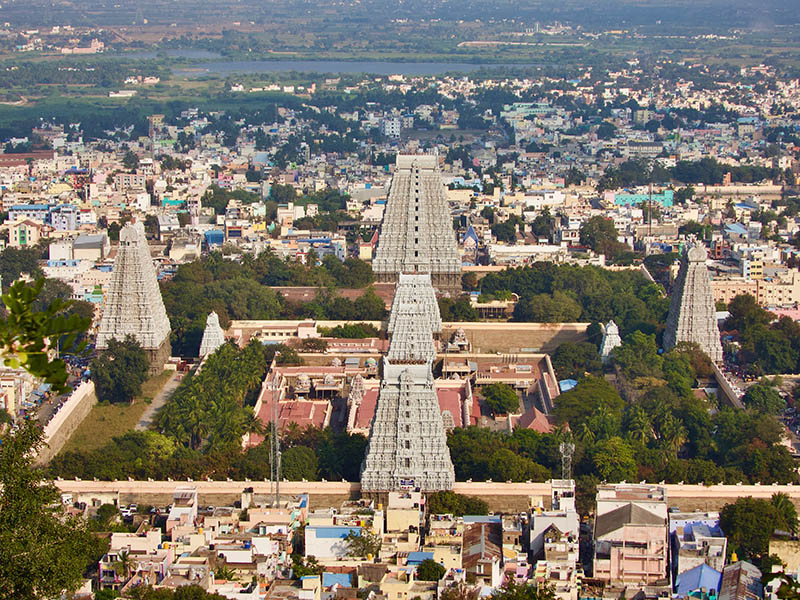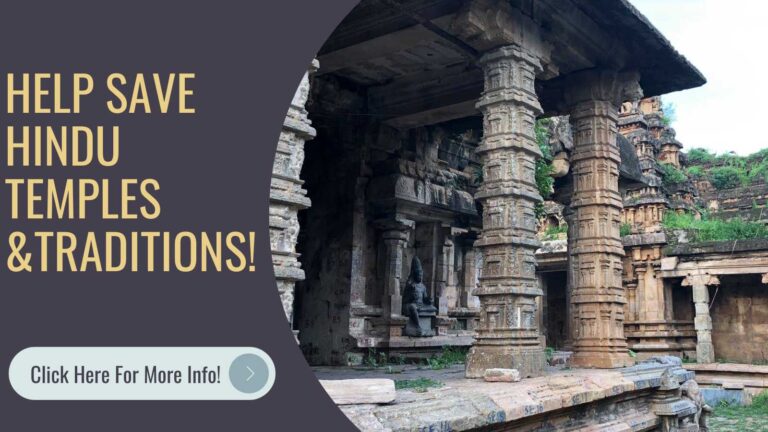
Arulmigu Arunachaleswarar Temple, Thiruvannamalai
India—the land of several centuries-old temples, is a heritage rich country. The southern region boasts of ancient architectural beauty adorning its coastline. Attracting lakhs of visitors and pilgrims every year, the South Indian temples hold mystical significance, and contribute to the development of the country. Each of these sacred places has significant beliefs and mystical facts associated with them which add to their unique history attached to them. Each is associated with unique, mystical facts.
Such are the Pancha Bhoota Sthalams—the five, centuries-old, highly revered temples situated in the South Indian states of Tamil Nadu and Andhra Pradesh. All of them are dedicated to Lord Shiva.
The Indian tradition recognizes that the universe comprises of five cosmic elements with which every life is made —Earth, Water, Fire, Air, and Sky. All of these elements are manifested in the five temples of Pancha Bhoota Sthalam with the presiding deity as Lord Shiva.
The five temples are—Thiruvanaikaval Jambukeshwara (water), Kanchipuram Ekambareswarar (earth), Chidambaram Nataraja (sky), Thiruvannamalai Arunachaleshwarar (fire) and Kalahasti Nathar (air).
An introduction about Temple
Tiruvannamalai district is one of the most venerated places in the South Indian state of Tamil Nadu as it endures the largest Lord Shiva temples in India—the Arulmigu Arunachaleswarar Temple, one of the Pancha Bhoota Sthalams. Also known as Annamalaiyar Temple, it manifests the element of fire (Agni). The Lingam here is referred to as Agni Lingam.
Here, Lord Shiva is said to have manifested himself as a massive column of fire, whose beginning and end could not be found by Brahma and Vishnu.
The presiding deity is Arunachaleshwara or Annamalaiyar (Lord Shiva), with his consort Goddess Parvathi depicted as Unnamalai Amman (Apitakuchambaal).
The temple has grandeur architecture and is rich in beliefs, spiritual heritage and festivals.

Significance of Girivalam (circumambulation)
It is said that Lord Shiva established himself as ‘Jyoyirlinga’ in a sacred hill behind the temple.
The sacred hill, almost 2668 feet high, itself is Lord Annamalaiyar here.
Performing ‘Girivalam’ or circumambulation every full moon day is considered an auspicious spiritual activity, carried on a 14 kilometres long path. Facts state that every full moon day, the temple witness lakhs of devotees circumambulating the Hill.
It is believed that performing Giri Pradakshina provides peace of mind and good health. The holy walk is also said to relieve the devotees from their cycle of birth and rebirth.
The district administration has installed bore well pumps, supplies milk, and even organizes annadhanam on special occasions to benefit pilgrims performing Girvalam. Also, a South Indian artist Thiru Rajnikanth donated sodium lamps to be installed on the pathway for pilgrims carrying out the activity at night.
Religious significance of the temple
When talking of all the temples dedicated to Lord Shiva’s manifestation, the Arunachala Temple is considered the most sacred of all the names. The Agni Lingam in the temple symbolizes self-sacrifice, liberation, duty, and virtue.
The Tiruvannamalai Arunachalam Temple is one of the four sacred places revered for obtaining salvation, as mentioned in Hindu sacred texts. It is believed that by worshipping Lord Arunachaleswarar one attains salvation (Ninaithale Mukthi Tharum Thiruthalam).
The temple complex, along with the sacred hill is said to emit strong positive vibrations. Even today some people claim to have seen saints deep in meditation at the site.
The temple area houses several ashrams and samadhis dedicated to different Indian saints and spiritual leaders.

History of the Temple
Believed to be the largest temple of Lord Shiva in the world, the Tiruvannamalai Arunachalam Temple’s existence dates back to several thousand years.
The inscriptions found show that the temple is believed to be built by Chola Kings in the 9th century, between 850 CE to 1280 CE. There were also inscriptions from the rule of Vijayanagara kings, Sangama dynasty, Saluva dynasty, and Tuluva dynasty.
The Cholas, Pallavas, Pandayas, the Hoysalas, the Nayaks of Thanjavur the Kadavarayas, and the Banas, have also contributed to the renovation and development of the vast temple complex.
The temple has 5 prakarams which are said to be built at different times. There is no official evidence regarding when the first and second prakarams came into existence. Third prakaram, however, was built in the 12th century, and fourth and fifth prakaras were built in 16th century.
The temple also faced the wrath of the ownership battle between the Hindus and Muslims, after the Mughal Empire came to an end.
The Archaeological Survey of India in 2002, then finally declared the temple a national heritage monument and took over its governance.
Stories about the temple
Lingothbavar
Lord Brahma and Lord Thirumal (Vishnu) started arguing to determine who the superior among them was. They asked Lord Shiva to judge. Lord Shiva then transformed into a massive cosmic pillar of fire (Jyothi) touching heaven and earth and asked them both to find His crown and feet.
Lord Vishnu took the avatar of a wild boar and dug deep into the earth to find ‘jyothi’s’ feet, but in vain. Lord Brahma took the avatar of a swan and set out to find Lord Shiva’s crown. Lord Brahma met thazhambu flower (an aromatic flower which had adorned Lord Shiva’s crown) and a cow, on his way up. They both acted as false witness to Lord Brahma’s lie of finding the crown.
Angered by the deception, Lord Shiva cursed Lord Brahma that there will be no temple on earth to worship him. He also cursed the flower saying it would be unfit to use while worshipping Him. He cursed the cow that looking at a cow’s face first thing in the morning will be considered a bad omen.
Thus, Thiruvannamalai is the holy place where Lord Shiva turned to a column of fire to eliminate the ego.
It is said that when Lord Shiva appeared as a massive cosmic pillar of fire, Lord Vishnu and Lord Brahma requested Him by their devoted prayers to transform into a less raging form for the benefit of humankind. On their request, Lord Shiva took the form of Shivalingam, situated at the foot of the Hill, where the present Arulmigu Annamalaiyar Temple is located.
Arthanareeswarar
Legend has it that once Goddess Parvathi playfully closed Lord Shiva’s eyes, plunging the world into ultimate darkness. As a penance, devi moulded a Shivalingam out of sand at Kanchipuram and started worshipping it.
Lord Shiva then asked her to go to Thiruvannamalai and do penance to get half of His body. While devoted in her prayers, a demon called Makidasuran tried to disturb her penance. Goddess Parvathi then took the form of Goddess Durga and destroyed the demon on the full moon day of the Tamil month of Karthigai. Then Lord Shiva presented himself in the form of holy fire on top of the Hill and combined Goddess Parvathi with Him on the left half of his body.
Thus, to venerate this event, every year in the Tamil month of Karthigai, at exactly at 6.00 p.m. Lord Arthanareeswarar, present in the form of Lingam, transforms Himself in “Jyothi Swaroopa” and bestows his devotees with his blessings on the 10th day of the festival.
Saints and Literary works associated with temple
The greatness of a temple is measured by its mentions in literary work and by the great saints. Tiruvannamalai Arunachalam Temple boasts of its mention in the Thevaram and Thiruvasagam, the two great works in Tamil.
It has been classified as Paadal Petra Sthalam by Tamil saint poets called Nayanars. Lord Annamalaiyar is revered in the Tevaram—the 7th century Tamil Shiva work.
Saint poets Sundarar, Thirunavukkarasar, and Thirugnana Sambandar, have visited the temple and composed divine poems. Saint Manickavasagar had composed “Thiruvempavai – 20” and “Thiruvammanai” here.
Thiruvannamalai has also been the abode of Siddhars, and saints like Arunachala Desikar, Guru Namachivayar, Gugai Namachivayar, Deivasigamani, Arunagirinathar, Sri Yogi Ram Surathkumar, Vitpatchathevar, Bagawan Ramana Maharishi, Mahan Seshadri Swamigal, and others alike.


Architecture of the temple
Situated in Arunachala’s foothills, the east-facing Arunachalam temple is an architectural masterpiece, with carvings and paintings resembling Hoyasala and Vijayanagara culture.
Spread over a sprawling 25 acres, the temple tower (Rajagopuram) is 41 metres tall and 30 metres wide. The temple stands high with nine huge towers and nine Prakarmas. It is surrounded by four high stone walls, resembling a fort. Comprising of 56 courtyards, the temple also houses two tanks and thousand-pillared hall.
The sanctum sanctorum has Lingodbhavar—an image of Lord Shiva emerging from the Shivalingam. The shrine of Unnamulai Amman lies in the second precinct.
There is Pathala Lingam, the underground lingam, in the temple. It is said to be the place where Ramana Maharsh is believed to have performed his penance.
Interesting facts
The Thiruvannamalai Annamalaiyar Temple, a marvel of architecture and mysticism, is unique in countless ways. But there are some interesting and less known facts which make it more venerated.
- All five temples of Pancha Bhoota Sthalams are geographically aligned in almost a straight line. This positioning is astonishing as the temples were built centuries ago when no satellite technology or GPS existed. The mysterious, highly accurate alignment of the temples is a geographical, engineering, and astronomical miracle in itself.
- It is believed that during the Krithayugam, the Annamalai hill existed in the form of fire. In the Threthayugam, it turned to an emerald hill (Manikkam). While in the Dwaparayugam, it was a Golden hill (Pon), and finally in the Kaliyugam, it became a solid rock hill.
Conclusion
The South Indian ancient temples attract thousands of domestic and international pilgrims daily. Apart from admiring their architectural beauty, the devotees worship at the sanctum sanctorum and gain Lord Annamalaiyar blessings, thereby moving on the path of salvation.
Karthigai Deepam is the most revered festival of the town, celebrated at Arunachalam Temple that swells the temple with crowd from across the globe. The grand, ten-day festival is celebrated in the in the Tamil month of Karthigai, which falls roughly between November and December. It culminates in the lighting of the ‘Mahadeepam’ on the sacred Tiruvannamalai hill at sunset.


